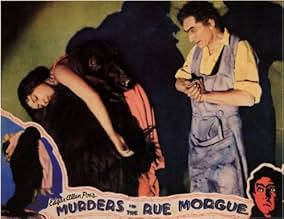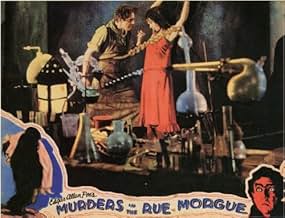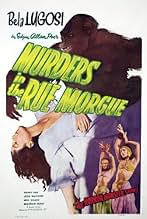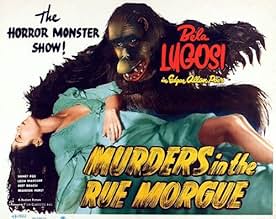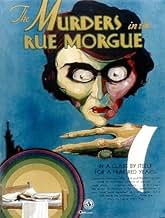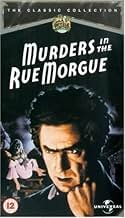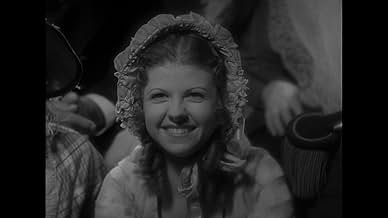ÉVALUATION IMDb
6,3/10
5,6 k
MA NOTE
Ajouter une intrigue dans votre langueA mad scientist seeks to mingle human blood with that of an ape, and resorts to kidnapping women for his experiments.A mad scientist seeks to mingle human blood with that of an ape, and resorts to kidnapping women for his experiments.A mad scientist seeks to mingle human blood with that of an ape, and resorts to kidnapping women for his experiments.
- Prix
- 1 victoire au total
Leon Ames
- Pierre Dupin
- (as Leon Waycoff)
Ted Billings
- Sideshow Spectator
- (uncredited)
Herman Bing
- Franz Odenheimer
- (uncredited)
Joe Bonomo
- Gorilla
- (uncredited)
Agostino Borgato
- Alberto Montani
- (uncredited)
Iron Eyes Cody
- Indian at Sideshow
- (uncredited)
Christian J. Frank
- Gendarme Using Snuff
- (uncredited)
Charles Gemora
- Erik, the Gorilla
- (uncredited)
Harrison Greene
- Sideshow Barker
- (uncredited)
Charlotte Henry
- Blonde Girl in Sideshow Audience
- (uncredited)
Histoire
Le saviez-vous
- AnecdotesMany censors cut parts of the death scenes of the woman (Arlene Francis) of the streets - eliminating her stabbing and being tied to the cross beams.
- GaffesIn many scenes, the close-up of a chimpanzee is used for the gorilla.
- Citations
Dr. Mirakle: [Responding to an audience member who has accused him of heresy] Heresy? Do they still burn men for heresy? Then burn me monsieur, light the fire! Do you think your little candle will outshine the flame of truth?
- Générique farfeluAt the end of the film, the cast list is shown again with the heading, "A GOOD CAST IS WORTH REPEATING...."
- Autres versionsWhen originally released theatrically in the UK, the BBFC made cuts to secure a 'A' rating. All cuts were waived in 2001 when the film was granted a '12' certificate for home video.
- ConnexionsEdited into Mondo Lugosi - A Vampire's Scrapbook (1987)
Commentaire en vedette
Murders in the Rue Morgue (1932)
King Kong was released by RKO in 1933, a story of an ape captured by white hairless apes and brought to a foreign land. And this is exactly the beginning of the 1932 Rue Morgue, as Bela Lugosi, playing Dr. Mirakle, appears as flamboyant sideshow impresario with an ape in a cage. His trick (if it is one) is knowing how to translate ape talk to English (or French, maybe, since we are in Paris). His point is that the apes are us, that evolution is true. "Can you understand what he says? Or have you forgotten?" Not the most honorable spokesman for science, no doubt, but he is a mad scientist, and is setting out to create some kind of unexplained human/ape hybrid.
The movie is filled with dramatic innovations, and a very high technical standard (for Universal, a minor studio player until this time). And the transfer to DVD is terrific. Ten minutes into the film, Lugosi breaks the fourth wall and looks into the camera to challenge the viewer to accept evolution and its consequences.. (The Scopes trial was 1925, so this is a hot topic.) Watch for the camera attached to the swing about 32 minutes in. There are echoes of Frankenstein (1931) with the madman and his doltish assistant, as well as the angry mobs. And there is Lugosi himself, with all the aura carrying over from his breakthrough in Dracula (also 1931).
The cinematography by Karl Freund is totally amazing. There are not astonishing tricks, just consistent, brilliant framing and lighting, scene after scene. (If only he had shot Dracula--oh, he did! Yes...check that out, too.) 1920s German Expressionist films find a true expression here (not Caligari, for sure, but a high water mark for American movies of the time). Simple things like shadows and angles, of course, but also moving camera in subtle ways (the camera falling slightly when approaching someone in a window, for example). Completely first rate.
It's common in these movies to have eccentric villains, grotesque monsters, and Gothic settings with wild special effects. And to have the common person as a balance to all this madness. These apply a little comic relief but in a silly way from our perspective. (The "common" person at the time in other movies was far more vivid and timeless, like Crawford or Cagney, but that would overwhelm the villains as well as the budget). In this case, one of the common folk is a resourceful doctor, and this search for the bad guy takes on a larger role than in the other monster movies.
The movie isn't a sparkling masterpiece. The acting throughout (even by Lugosi, really) isn't always spot on, but it works overall, and is consistent. There is a comic moment near the end (when we are most anxious for action) where the character have an argument in different languages, and it's so perky I'm assuming they felt they couldn't take it out, but it doesn't advance the plot. It does deal with Logosi's characteristic odd accent. And for fun, there is an anachronism, half an hour in, when a bicycle rides through the little town, decades before they were made like that.
It won't matter if you don't believe in evolution. The movie plays loose with the concept, and Dr. Mirakle says at one point, with his beady eyes: "Do you think your little candle can outshine the truth?"
King Kong was released by RKO in 1933, a story of an ape captured by white hairless apes and brought to a foreign land. And this is exactly the beginning of the 1932 Rue Morgue, as Bela Lugosi, playing Dr. Mirakle, appears as flamboyant sideshow impresario with an ape in a cage. His trick (if it is one) is knowing how to translate ape talk to English (or French, maybe, since we are in Paris). His point is that the apes are us, that evolution is true. "Can you understand what he says? Or have you forgotten?" Not the most honorable spokesman for science, no doubt, but he is a mad scientist, and is setting out to create some kind of unexplained human/ape hybrid.
The movie is filled with dramatic innovations, and a very high technical standard (for Universal, a minor studio player until this time). And the transfer to DVD is terrific. Ten minutes into the film, Lugosi breaks the fourth wall and looks into the camera to challenge the viewer to accept evolution and its consequences.. (The Scopes trial was 1925, so this is a hot topic.) Watch for the camera attached to the swing about 32 minutes in. There are echoes of Frankenstein (1931) with the madman and his doltish assistant, as well as the angry mobs. And there is Lugosi himself, with all the aura carrying over from his breakthrough in Dracula (also 1931).
The cinematography by Karl Freund is totally amazing. There are not astonishing tricks, just consistent, brilliant framing and lighting, scene after scene. (If only he had shot Dracula--oh, he did! Yes...check that out, too.) 1920s German Expressionist films find a true expression here (not Caligari, for sure, but a high water mark for American movies of the time). Simple things like shadows and angles, of course, but also moving camera in subtle ways (the camera falling slightly when approaching someone in a window, for example). Completely first rate.
It's common in these movies to have eccentric villains, grotesque monsters, and Gothic settings with wild special effects. And to have the common person as a balance to all this madness. These apply a little comic relief but in a silly way from our perspective. (The "common" person at the time in other movies was far more vivid and timeless, like Crawford or Cagney, but that would overwhelm the villains as well as the budget). In this case, one of the common folk is a resourceful doctor, and this search for the bad guy takes on a larger role than in the other monster movies.
The movie isn't a sparkling masterpiece. The acting throughout (even by Lugosi, really) isn't always spot on, but it works overall, and is consistent. There is a comic moment near the end (when we are most anxious for action) where the character have an argument in different languages, and it's so perky I'm assuming they felt they couldn't take it out, but it doesn't advance the plot. It does deal with Logosi's characteristic odd accent. And for fun, there is an anachronism, half an hour in, when a bicycle rides through the little town, decades before they were made like that.
It won't matter if you don't believe in evolution. The movie plays loose with the concept, and Dr. Mirakle says at one point, with his beady eyes: "Do you think your little candle can outshine the truth?"
- secondtake
- 5 mars 2010
- Lien permanent
Meilleurs choix
Connectez-vous pour évaluer et surveiller les recommandations personnalisées
Détails
- Date de sortie
- Pays d’origine
- Langues
- Aussi connu sous le nom de
- Ubistva u ulici Morg
- Lieux de tournage
- société de production
- Consultez plus de crédits d'entreprise sur IMDbPro
Box-office
- Budget
- 190 000 $ US (estimation)
- Durée1 heure 1 minute
- Couleur
- Rapport de forme
- 1.37 : 1
Contribuer à cette page
Suggérer une modification ou ajouter du contenu manquant

Lacune principale
By what name was Murders in the Rue Morgue (1932) officially released in India in English?
Répondre

